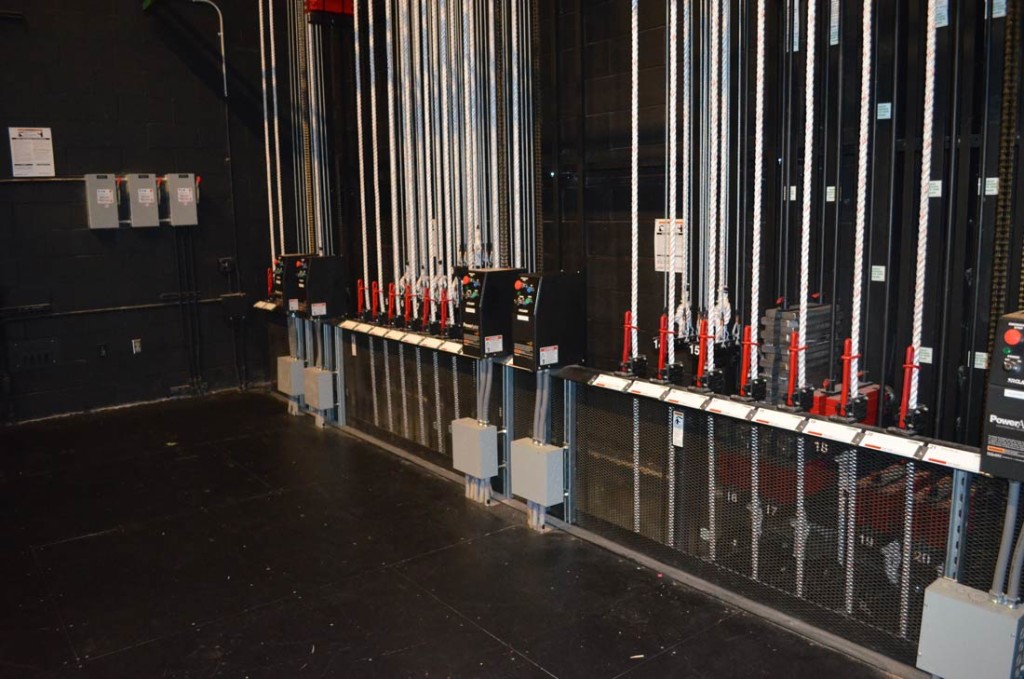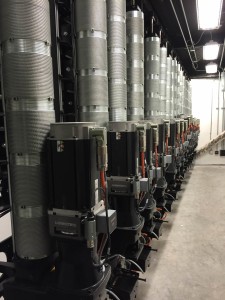The Ups and Downs of Stage Rigging
The “Ups and Downs” of Stage Rigging
Automated Stage Rigging Systems: The right choice?

A high school stage with a combination of manual counterweight rigging and a few motorized linesets for heavy loads. Photo by Paul G. Sanow, ASTC.
Innovation in the theatre world is essential to support ever evolving audience expectations and the creative process. In the past, innovation has been an essential part of theatre systems design except for the traditional manually operated, counterweighted stage rigging system. For decades, this system has changed little and has become the true workhorse of the theatre. However, in recent years, innovations in motorized computer controlled stage rigging systems have made motorized rigging more prevalent and a viable option in performance venues of every scale.
To keep pace with evolving audience expectations, clients are increasingly interested in the benefits of an automated stage rigging system. Theatre consultants are often asked to assist clients with deciding which type of stage rigging system is most appropriate for the client’s project. Four important considerations are the types and frequency of productions, operational safety, comparative costs, and the end users’ technical sophistication.
The types and frequency of productions will determine the functional requirements of the stage rigging system. Will the types of productions require the stage rigging system to only handle a fixed overhead load with traveler tracks to move curtains and scenery on and off stage? Do the expected presentational requirements dictate a system that can manage moving overhead loads up and down? And, if the required system needs to move loads vertically, is it better to accomplish this manually or automatically? Deliberate discussions with the venue managers, presenters, and end users are required to gain insight into answering these questions.
Safety considerations include safe access to the stage rigging system components, the ability of the stage rigging system to perform the intended tasks without failure, and the operational proficiency of the users. For manually operated stage rigging systems, a counterweight loading bridge, an operator locking rail, a walkable gridiron, and vertical access are required. The loading bridge must be designed to carry the heavy load of the system counterweights which store there when not in use. The locking rail must be located with a clear view of the entire stage during system operation and be well lit. The gridiron and vertical access also require careful planning, taking system functionality into account.

Machine Room at Alley Theatre, Houston, TX. Variable, high speed hoists are installed along the wall of the theatre. Photo by Paul G. Sanow, ASTC.
For an automated stage rigging system, the counterweight storage and loading bridge is not required but standard personnel catwalks to access motors, electronics, and other rigging components are necessary. An operator locking rail is not required as the operator sits or stands at a computerized stage rigging controller. However, this control area must also be located with a clear view of the entire stage during system operation and be well lit. The gridiron and access devices require the same careful planning. Additionally, specific electronic system fail-safes and movement sensors are required for a motorized stage rigging system. Superior operational proficiency of the users is essential for both manual and automated stage rigging system safety because moving loads over people’s heads carries risk.
Cost considerations must include the genuine cost premium of an automated system versus a manual system, the comparative cost impact on the building structural requirements for each type of system, the additional electrical system design costs associated with an automated system, and the ongoing costs of operation, inspection, and maintenance for each type of system. The component cost of a manually operated stage rigging system is much less than the cost of a fully automated stage rigging system. However, continuing innovation with packaged motorized hoist systems and programmable controllers is constantly reducing this cost premium percentage. The cost impact on the building structure is less for a motorized stage rigging system (no high capacity loading bridge and operating rail required), but this is certainly offset by the additional electrical cost requirements. Operation, inspection, and maintenance costs are similar for both systems with an automated system requiring additional electrical inspection and maintenance, and periodic software updates.
In the end, automated stage rigging systems may cost more, but safety is paramount. Historically, motorized rigging was found in technically sophisticated opera houses and regional performing arts venues with well trained, experienced personnel. As more sophisticated systems are appearing in local venues, a more rigorous approach to safety is required precisely because those venues have less-experienced personnel operating them. Manufacturers of automated stage rigging systems are responding to this condition with built-in safety features like slack line detection, load cells, absolute encoders, hard struck limits and an internal safety diagnostic monitoring system that checks to ensure the hoist is operating properly. These systems will also store time stamped information in the computer controller to give important operational and inspection information to a trained maintenance professional.
Innovation in the performing arts is a fact of life. The musical touring industry has helped to support the development of more advanced and affordable motorized rigging. These recent innovations in automated stage rigging system design have made creative opportunities available to users who previously couldn’t afford this equipment. Motorized rigging systems are becoming more prevalent in high school theatres because of their apparent safety compared to manual rigging. However, with the availability that this innovation allows also comes the necessity of educating users in the proper operation, inspection, and maintenance of these sophisticated systems. A theatre consultant proficient in the design of these types of systems is essential to educate, assist, and guide clients through the complex choice of motorized versus manually operated stage rigging systems.
By Stephen Placido, ASTC


